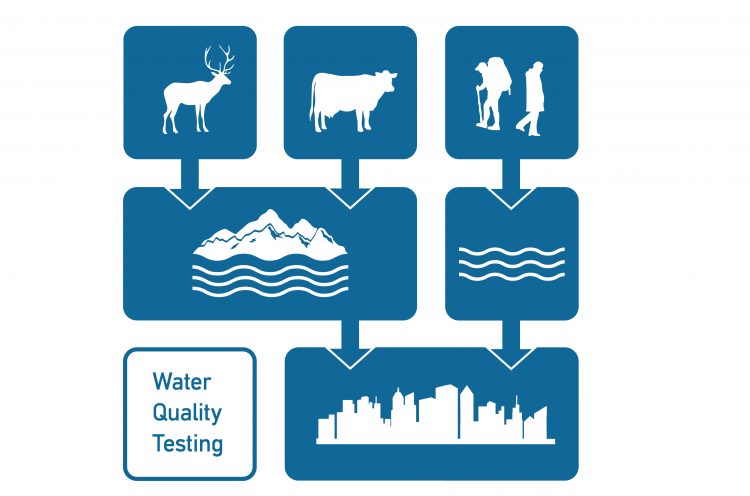TU Wien develops quick tests for food and water

Allergens, toxins, harmful microorganisms or faecal contamination – there is a long list of substances which we would prefer not to have in our food or our drinking water. TU Wien has developed new methods using quick tests for various biological substances, which have now been thoroughly tested and are simple to use.
The objectives of these new methods are simple on-site application, as well as independence from laboratories and expensive instruments. These tests are now ready for market launch and should ensure that in future many tests can be carried out without sending samples to the laboratory.
Simple test strips using aptamers
Aptamers are short DNA fragments, which form unusual 3D structures due to their unique folding. These structures are formed in a way that allows them to detect any selected target molecule, the analyte, and dock onto it with a powerful bonding force. The correct DNA folding for a particular analyte is discovered using a kind of accelerated evolution in the test tube: Over several stages, the process creates increasingly similar DNA sequences, making this an extremely flexible and rapid to implement method.
With the aid of the correct aptamer, a test strip can be produced, similar to a conventional pregnancy test. Alternatively, a liquid, the colour of which changes visibly in the presence of the analyte can be produced. Both of these enable simple detection of unwanted substances without the use of a laboratory.
DNA reproduction for successful trace analysis
Tests must be able to reliably detect the smallest quantities of biological material, even when only a few cells are present. This is particularly important in the case of food allergens, as even the smallest traces can trigger allergic reactions. The situation is similar in the case of drinking water: even individual bacteria of faecal origin can be sufficient to make drinking water unsuitable for consumption.
A special method is used to detect such small quantities: in order to reproduce (amplify) DNA by means of a polymerase chain reaction (PCR), enzymes are used which can replicate the DNA sequences. The research team at TU Wien has developed PCR methods for the reliable detection of moulds, drinking water pathogens, food allergens or genetically modified organisms, even in extremely small quantities: as few as 3-10 cells can be detected.
New methods for simpler tests
It has even been possible to go one step further and to considerably simplify the detection of a whole series of analytes. Instead of the complicated PCR method, 'isothermal amplification methods' can now be used. These also copy DNA sequences, albeit with a lower level of complexity. While expensive instruments, fixed installation locations and a constant ambient temperature are usually required for PCR, the new methods only require an inexpensive heating block which can be powered with batteries. These methods are also much less sensitive to external contamination. Using this new generation of test methods from TU Wien it is possible to operate independently of laboratories and to carry out reliable analyses directly on site.
The new tests have already been intensively tested on a wide range of foods: raw agricultural products have been tested, as well as industrially produced foods which had been subjected to complex processing. Furthermore, drinking water analysis systems from TU Wien are now being used in cooperation with large utility companies. In view of this resounding success, the technology is now to be extended to other problems in the food industry – for example the detection of horse meat, basmati rice and various species of fish.
Presentation in Hanover
At the Hanover Fair from 7 to 11 April, the TU Wien and its start-up BioTrac will present the latest developments in the food and drinking water analysis sector. Companies from the food and beverage sector, biotechnology and large utility companies can benefit enormously from the new methods, both in terms of time and cost.
You can now register as an editor or journalist for a guided press tour through the shared TU Wien stand. Please register at: forschungsmarketing@tuwien.ac.at
For further information about the TU Wien presentation at the Hanover Fair:
http://www.tuwien.ac.at/HM2014/
For more information, please contact:
About the TU Wien presentation at the Hanover Fair:
Peter Heimerl
Research Marketing
Vienna University of Technology
Karlsplatz 13, 1040 Wien, Austria
Tel: +43 (1) 58801-406110
M: +43 (0)664-605 88 3320
peter.heimerl@tuwien.ac.at
For scientific questions:
Dr Kurt Brunner
Institute of Chemical Engineering
Vienna University of Technology
IFA-Tulln, Analysis Centre Konrad Lorenz Str. 20, 3430 Tulln
Tel: +43-2272-66280-405
M: 43-(0)-664-605883456
kurt.brunner@tuwien.ac.at
Prof. Robert Mach
Institute of Chemical Engineering
Vienna University of Technology
Gumpendorfers Straße 1a, 1060 Wien, Austria
Tel: +43-(1)-58801-166502
robert.mach@tuwien.ac.at
TU Wien – member of TU Austria
www.tuaustria.at
http://www.tuwien.ac.at/HM2014/ Further information about TU Vienna at the Hanover Fair
Media Contact
All latest news from the category: HANNOVER MESSE
Newest articles

A universal framework for spatial biology
SpatialData is a freely accessible tool to unify and integrate data from different omics technologies accounting for spatial information, which can provide holistic insights into health and disease. Biological processes…

How complex biological processes arise
A $20 million grant from the U.S. National Science Foundation (NSF) will support the establishment and operation of the National Synthesis Center for Emergence in the Molecular and Cellular Sciences (NCEMS) at…

Airborne single-photon lidar system achieves high-resolution 3D imaging
Compact, low-power system opens doors for photon-efficient drone and satellite-based environmental monitoring and mapping. Researchers have developed a compact and lightweight single-photon airborne lidar system that can acquire high-resolution 3D…





















